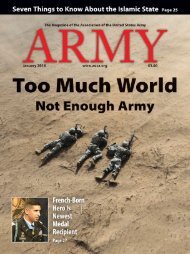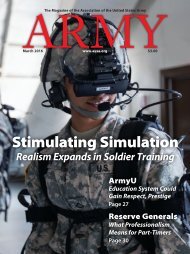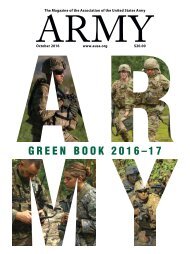Army - Kicking Tires On Jltv
You also want an ePaper? Increase the reach of your titles
YUMPU automatically turns print PDFs into web optimized ePapers that Google loves.
Front & Center<br />
Readiness and Capability Are Intertwined<br />
By Gen. Frederick J. Kroesen, U.S. <strong>Army</strong> retired<br />
There is no question about readiness<br />
being the prime responsibility of today’s<br />
<strong>Army</strong> leaders. Every public speaker,<br />
report, news column and magazine article<br />
stresses the requirement and commitment<br />
necessary to guarantee combatready<br />
forces to meet the demands of<br />
national security.<br />
I have no argument with that requirement,<br />
having lived with it in every command<br />
assignment from World War II<br />
through the Cold War. But during my<br />
years of senior command, if anyone<br />
asked for a one-word identification of<br />
my prime responsibility, I would have<br />
answered “capability.”<br />
Readiness is the responsibility of combat<br />
and combat support forces that may<br />
be committed immediately to a crisis situation—those<br />
closest to the crisis at the<br />
highest degree of readiness. Battalion and<br />
company commanders bear the brunt,<br />
but platoon and squad leaders are the<br />
front line of action. Squad leaders ensure<br />
each soldier knows his or her job and has<br />
the skills required by his or her MOS.<br />
They also create the confidence and team<br />
spirit essential for combat operations.<br />
Platoon leaders ensure that squad<br />
leaders have done their jobs, then mold<br />
the teams that must be ready to engage<br />
in the tactical tasks they are expected to<br />
perform. Company commanders supervise<br />
and validate readiness training; they<br />
also are responsible for the first rung of<br />
the capability ladder as they exercise the<br />
ability to call for and employ intelligence,<br />
fire support, logistics and coordination<br />
with other companies engaged in combat<br />
operations. They are the principal contributors<br />
to the development of the next<br />
war’s band of brothers.<br />
Battalion and brigade commanders<br />
also supervise readiness, but their primary<br />
concerns are adequate planning and then<br />
directing operations. Requiring their attention<br />
as battle action unfolds are communications<br />
that obtain fire support and<br />
resupply, maintain contact with adjacent<br />
units and higher and lower echelons, and<br />
control the activities of attached units.<br />
Division and corps commanders direct<br />
combat campaigns. They supervise readiness<br />
training during peacetime, but must<br />
presume readiness when ordered to combat.<br />
They direct combat activities, make<br />
decisions essential for sustaining operations,<br />
and ensure their staffs are sustaining<br />
the support requirements of their<br />
subordinate units. They are also responsible<br />
for recommending or requesting<br />
the additional support or resources that<br />
could expedite action or prevent failure.<br />
The highest commands in a theater of<br />
operations are almost completely concerned<br />
with capability. They must assume<br />
the readiness of the forces committed<br />
to them by the services as they plan<br />
their campaigns, guaranteeing mission<br />
success or explaining the risks involved<br />
and recommending steps to alleviate<br />
those risks.<br />
A perfect example of such a requirement<br />
was the request for an additional<br />
corps in the troop list for the Persian<br />
Gulf campaign in 1990–91. The same<br />
responsibility is borne by the Joint<br />
Chiefs of Staff and the Pentagon, where<br />
the ultimate demands of combat operations<br />
must be satisfied.<br />
When a national crisis occurs, the<br />
president is concerned almost exclusively<br />
with capability. After approving the National<br />
Military Strategy and with assurances<br />
by the Joint Chiefs of the adequacy<br />
of forces to accomplish missions appropriate<br />
to that strategy, he or she can confidently<br />
make decisions to achieve political<br />
objectives. When that system works<br />
as designed, we have military operations<br />
like Just Cause in Panama and Desert<br />
Storm in the Persian Gulf. When the<br />
system is not operable, we have had<br />
World War II and three years of losses,<br />
the Bataan Death March and the Battle<br />
of Kasserine Pass while building the<br />
forces necessary to win in Europe and<br />
the Pacific; and we have had Korea and<br />
the infamous Task Force Smith tragedy.<br />
More recently, we have had unsatisfying<br />
results in Iraq and Afghanistan, where<br />
initial successes were squandered by inadequate<br />
or overcommitments and early<br />
withdrawals.<br />
Fulfilling such a national strategy today<br />
would require an <strong>Army</strong> closer to the<br />
780,000 strength of Just Cause and the<br />
Persian Gulf than the 450,000 currently<br />
programmed for the future. It would<br />
also require restoring the Navy and Air<br />
Force of the 1990s and a continuing<br />
modernization of our nuclear deterrent.<br />
We can hope that Congress and our<br />
presidential candidates are aware of<br />
such a need and will provide a budget<br />
that does not require the services to accommodate<br />
a too small number and a<br />
great risk.<br />
■<br />
Gen. Frederick J. Kroesen, USA Ret., formerly<br />
served as vice chief of staff of the<br />
U.S. <strong>Army</strong> and commander in chief of<br />
U.S. <strong>Army</strong> Europe. He is a senior fellow<br />
of AUSA’s Institute of Land Warfare.<br />
U.S. <strong>Army</strong>/Rick Rzepka<br />
February 2016 ■ ARMY 11

















